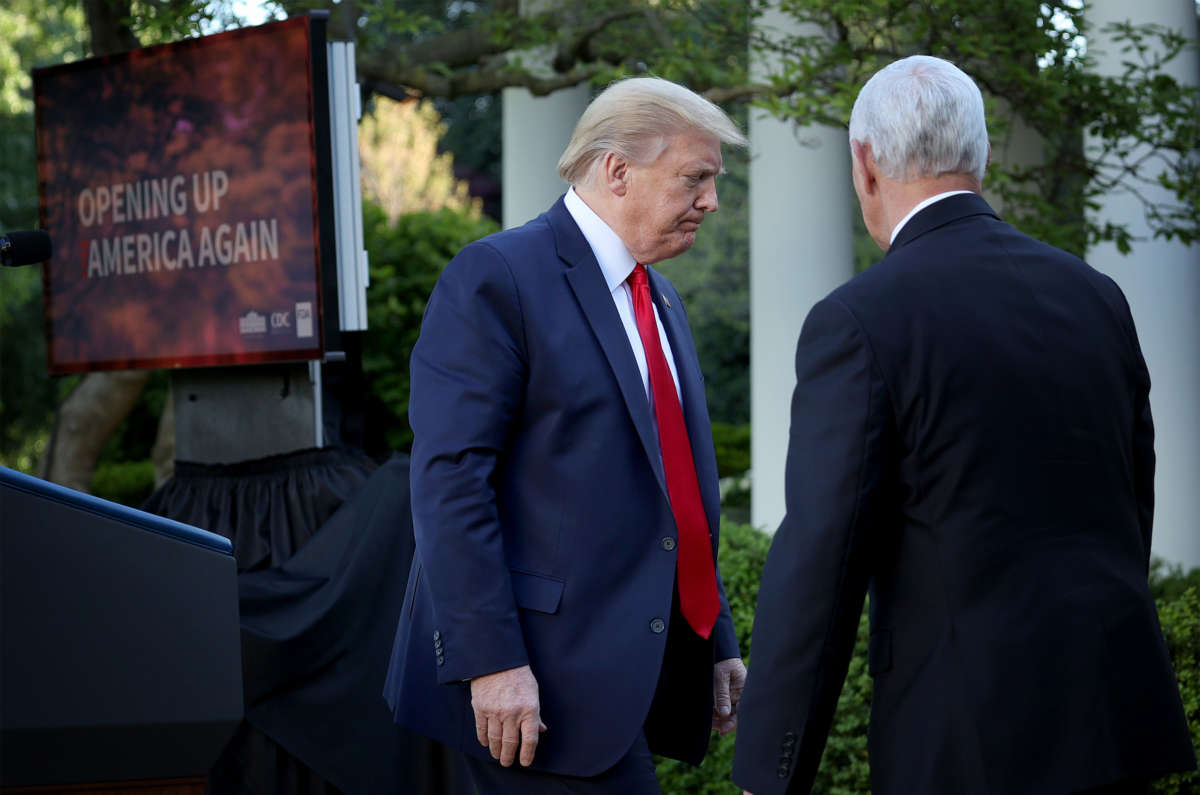President Donald Trump on Monday unveiled what the White House described as a “blueprint” for nationwide Covid-19 testing that public health experts say falls far short of the robust federal strategy needed to track and contain the deadly virus before states can safely begin reopening their economies.
A senior Trump administration official told the Wall Street Journal that the White House testing plan would provide all 50 states in the U.S. with enough equipment to test at least 2% of their residents. Ashish Jha, director of the Harvard Global Health Institute, said that number is nowhere close to adequate.
“It’s about 6 to 7 million [tests],” said Jha, “and if that’s one-time, that doesn’t do anything.”
The blueprint (pdf) is organized into an eight-part strategy that largely leaves states responsible for carrying out a massive expansion of testing, even as governors say they lack the equipment and capacity to ramp up screenings to the level that experts say is necessary.
The White House role, the blueprint says, is to “enable Innovation, scale supplies, and provide strategic guidance.” The document describes the federal government as a “supplier of last resort.” The administration also emphasized its partnership with the private sector; Trump on Monday met with executives from Walmart, CVS, Walgreens, and other companies to discuss their role in distributing and administering Covid-19 tests.
“We want to get our country open,” Trump said during a press conference in the Rose Garden of the White House on Monday evening. “And the testing is not going to be a problem at all. In fact, it’s going to be one of the great assets that we have.”
Democratic members of Congress, meanwhile, ripped the president’s testing plan as inadequate and accused the White House of abdicating its responsibility by putting the onus on states.
“This document does nothing new and will accomplish nothing new,” Sen. Patty Murray (D-Wash.) said in a statement. “It doesn’t set specific, numeric goals, offer a timeframe, identify ways to fix our broken supply chain, or offer any details whatsoever on expanding lab capacity or activating needed manufacturing capacity.”
“Perhaps most pathetically, it attempts to shirk obviously federal responsibilities by assigning them solely to states instead,” Murray added. “What we need is a clear, aggressive national strategic plan to dramatically ramp up testing and make sure tests are fast, free, and everywhere — and then we need the administration to implement it like people expect the president of the United States of America and his team to do.”
The White House plan came as governors of several states, including Texas and Ohio, pushed ahead with plans to reopen parts of their economies despite the lack of far-reaching testing capacity.
Trump, who has lied repeatedly about the level of testing in the U.S. relative to other major nations, told governors in a conference call Monday that they should “start to think about school openings” despite warnings against doing so from health professionals.
“The young children have done very well in this disaster that we’ve all gone through, so a lot of people are thinking about the school openings,” the president said on the call, according to the New York Times.
How vague and meaningless is this? pic.twitter.com/CghtqotTf9
— Aaron Rupar (@atrupar) April 27, 2020
Paul Romer, a Nobel Prize-winning economist at New York University, told the Times that testing 2% of residents in each state “is not enough to test everyone in healthcare even once, let alone to keep retesting them every day, which is what it would take to keep those who do get infected from going on shift and infecting their colleagues.”
Romer has recommended that the U.S. develop the capacity to test everyone in the nation once every two weeks, a strategy he estimates would cost around $100 billion.
“It’s totally in our control to fix this,” Romer told the Washington Post of the country’s inadequate testing. “We should be spending $100 billion on the testing. We should just get it going. It’s just not that hard.”
Our most important fundraising appeal of the year
December is the most critical time of year for Truthout, because our nonprofit news is funded almost entirely by individual donations from readers like you. So before you navigate away, we ask that you take just a second to support Truthout with a tax-deductible donation.
This year is a little different. We are up against a far-reaching, wide-scale attack on press freedom coming from the Trump administration. 2025 was a year of frightening censorship, news industry corporate consolidation, and worsening financial conditions for progressive nonprofits across the board.
We can only resist Trump’s agenda by cultivating a strong base of support. The right-wing mediasphere is funded comfortably by billionaire owners and venture capitalist philanthropists. At Truthout, we have you.
We’ve set an ambitious target for our year-end campaign — a goal of $250,000 to keep up our fight against authoritarianism in 2026. Please take a meaningful action in this fight: make a one-time or monthly donation to Truthout before December 31. If you have the means, please dig deep.
